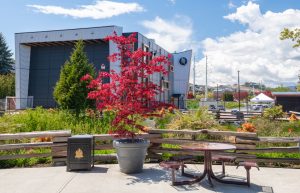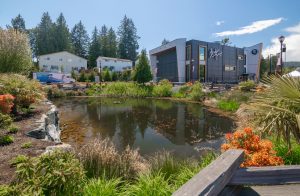As the calendar turns to a new year, businesses worldwide seek ways to revitalize their commercial spaces and create an environment that fosters productivity, creativity, and well-being. One increasingly popular and practical approach is the incorporation of greenery into commercial spaces, and the landscaping industry plays a pivotal role in bringing these visions to life.

The Advantages of Greenery in Commercial Spaces:
The benefits of integrating green elements into commercial environments are multifaceted and extend beyond mere aesthetics. Research consistently demonstrates that a green workplace can positively impact employee well-being, productivity, and satisfaction. Plants purify the air by absorbing pollutants and contribute to a more relaxed and focused atmosphere.
Moreover, greenery has been linked to reduced stress levels and increased creativity. A study published in the Journal of Environmental Psychology found that offices with plants experienced a 15% increase in productivity compared to those without. This alone is reason enough for businesses to consider incorporating greenery into their commercial spaces.

The Role of the Landscaping Industry:
Landscaping is crucial in transforming commercial spaces into lush, green havens. Professional landscape designers can work closely with businesses to understand their unique needs, brand identity, and the specific characteristics of the space. From indoor plant installations to outdoor landscaping, the expertise of landscape professionals ensures that the green elements seamlessly integrate with the overall design, enhancing the visual appeal and functionality of the space.

Practical Tips for Incorporating Greenery:
- Tailored Designs for Indoor Spaces:When integrating greenery indoors, consider the unique characteristics of the space. Low-light areas may benefit from shade-tolerant plants such as snake plants or pothos, while well-lit spaces can showcase vibrant flowering plants. Vertical gardens or hanging planters are innovative solutions for maximizing limited floor space.
2. Biophilic Design Principles: Embrace biophilic design principles, which focus on connecting people with nature within the built environment. Incorporate natural materials, textures, and patterns alongside plants to create a harmonious and balanced atmosphere. This contributes to the aesthetic appeal and promotes a sense of well-being.
3. Outdoor Oasis: Transform outdoor spaces into inviting retreats by strategically placing plants and greenery. Consider using native plants that thrive in the local climate, reducing the need for excessive maintenance and watering. Seating areas surrounded by greenery give employees and clients a rejuvenating outdoor escape.
4. Brand Integration: Align the choice of green elements with the brand identity of the business. For example, a tech company may opt for modern, sleek planters and minimalist greenery arrangements, while a creative agency might embrace a more eclectic and vibrant plant palette. Consistency in design fosters a cohesive and memorable brand experience.

Illustrative Examples:
- Google’s Biophilic Campus:
Google’s headquarters in Mountain View, California, is a prime example of a commercial space that seamlessly integrates greenery. The campus features outdoor workspaces surrounded by lush landscaping, creating a harmonious blend of nature and technology. The emphasis on greenery aligns with Google’s commitment to employee well-being and innovation.
2. Amazon’s Spheres:
Amazon’s Spheres in Seattle exemplifies greenery as a focal point in a commercial space. The Spheres house a diverse collection of plants, creating a tropical oasis for employees. This innovative approach enhances the aesthetic appeal of the workspace and provides a unique environment for collaboration and relaxation.
3. Co-Working Spaces with a Green Twist:
Many co-working spaces embrace incorporating greenery to enhance the working experience. Companies like WeWork are incorporating plants into their designs, recognizing the positive impact on productivity and well-being. Indoor plants, vertical gardens, and communal green spaces create a more vibrant and inviting atmosphere.
In conclusion, integrating greenery into commercial spaces, guided by the expertise of the landscaping industry, can elevate the overall experience for employees and clients alike. From improving air quality to boosting creativity and productivity, the advantages of February greenery extend far beyond the visual appeal. Businesses that prioritize creating a green and sustainable environment are investing in the well-being of their workforce and enhancing their brand image in an increasingly environmentally conscious world. As we enter a new year, let’s embrace the refreshing power of greenery to transform commercial spaces into vibrant, thriving hubs of innovation and collaboration.